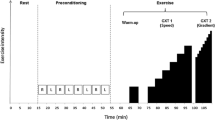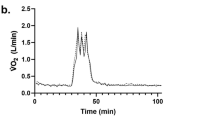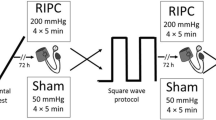Abstract
Purpose
Although ischaemic preconditioning (IPC), induced by cycles of transient limb ischaemia and reperfusion, seems to improve exercise performance, the optimal duration of ischaemia–reperfusion cycles is not established. The present study investigated the effect of ischaemia–reperfusion duration within each IPC cycle on performance in a 2000-m rowing ergometer test.
Methods
After incremental and familiarization tests, 16 trained rowers (mean ± SD: age, 24 ± 11 years; weight, 74.1 ± 5.9 kg; \(\dot{V}{\text{O}}_{{\text{2}}}\) peak, 67.2 ± 7.4 mL·kg−1·min−1) were randomly submitted to a 2000-m rowing test preceded by intermittent bilateral cuff inflation of the lower limbs with three cycles of ischaemia–reperfusion, lasting 5 min (IPC-5) or 10 min (IPC-10) at 220 or 20 mmHg (control). Power output, \(\dot{V}{\text{O}}_{{\text{2}}}\), heart rate, blood lactate concentration, pH, ratings of perceived exertion (RPE), and near-infrared spectroscopy-derived measurements of the vastus lateralis muscle were continuously recorded.
Results
No differences among treatments were found in the 2000-m test (control: 424 ± 17; IPC-5: 425 ± 16; IPC-10: 424 ± 17 s; P = 0.772). IPC-10 reduced the tissue saturation index and oxy-haemoglobin concentration during exercise compared with control. The power output during the last 100-m segment was significantly lower with IPC-10. The IPC treatments increased the heart rate over the first 500 m and decreased the pH after exercise. No alterations were observed in \(\dot{V}{\text{O}}_{{\text{2}}}\), blood lactate, or RPE among the trials.
Conclusion
In conclusion, IPC does not improve the 2000-m rowing ergometer performance of trained athletes regardless of the length of ischaemia–reperfusion cycles.




Similar content being viewed by others
Abbreviations
- La:
-
Blood lactate concentration
- O2Hb:
-
Oxy-haemoglobin concentration
- HHb:
-
Deoxy-haemoglobin concentrations
- AOD:
-
Accumulated oxygen deficit
- CTRL:
-
Control
- HR:
-
Heart rate
- HRpeak:
-
Peak heart rate
- LT:
-
Lactate threshold
- NIRS:
-
Near-infrared spectroscopy
- IPC:
-
Ischaemic preconditioning
- IPC-5:
-
Ischaemic preconditioning with cycles of 5-min ischaemia–reperfusion
- IPC-10:
-
Ischaemic preconditioning with cycles of 10-min ischaemia–reperfusion
- RPE:
-
Ratings of perceived exertion
- TSI:
-
Tissue saturation index
- \(\dot{V}{\text{O}}_{{\text{2}}}\) :
-
Pulmonary oxygen uptake
- \(\dot{V}{\text{O}}_{{\text{2}}}\)max:
-
Maximal oxygen uptake
- \(\dot{V}{\text{O}}_{{\text{2}}}\)peak:
-
Peak oxygen uptake
References
Abbiss CR, Laursen PB (2005) Models to explain fatigue during prolonged endurance cycling. Sports Med 35(10):865–898
Bailey TG, Jones H, Gregson W, Atkinson G, Cable NT, Thijssen DH (2012) Effect of ischemic preconditioning on lactate accumulation and running performance. Med Sci Sports Exerc 44(11):2084–2089. https://doi.org/10.1249/MSS.0b013e318262cb17
Barbosa TC, Machado AC, Braz ID, Fernandes IA, Vianna LC, Nobrega AC, Silva BM (2015) Remote ischemic preconditioning delays fatigue development during handgrip exercise. Scand J Med Sci Sports 25(3):356–364. https://doi.org/10.1111/sms.12229
Bazzucchi I, Sbriccoli P, Nicolo A, Passerini A, Quinzi F, Felici F, Sacchetti M (2013) Cardio-respiratory and electromyographic responses to ergometer and on-water rowing in elite rowers. Eur J Appl Physiol 113(5):1271–1277. https://doi.org/10.1007/s00421-012-2550-2
Borg GA (1982) Psychophysical bases of perceived exertion. Med Sci Sports Exerc 14(5):377–381
Bushell AJ, Klenerman L, Taylor S, Davies H, Grierson I, Helliwell TR, Jackson MJ (2002) Ischaemic preconditioning of skeletal muscle. 1. Protection against the structural changes induced by ischaemia/reperfusion injury. J Bone Joint Surg Br 84(8):1184–1188
Cocking S, Wilson MG, Nichols D, Cable NT, Green DJ, Thijssen DHJ, Jones H (2018) Is There an Optimal Ischemic-Preconditioning Dose to Improve Cycling Performance? Int J Sports Physiol Perform:1–9. https://doi.org/10.1123/ijspp.2017-0114
Cosgrove MJ, Wilson J, Watt D, Grant SF (1999) The relationship between selected physiological variables of rowers and rowing performance as determined by a 2000 m ergometer test. J Sports Sci 17(11):845–852. https://doi.org/10.1080/026404199365407
Crisafulli A, Tangianu F, Tocco F, Concu A, Mameli O, Mulliri G, Caria MA (2011) Ischemic preconditioning of the muscle improves maximal exercise performance but not maximal oxygen uptake in humans. J Appl Physiol (1985) 111(2):530–536. https://doi.org/10.1152/japplphysiol.00266.2011
Cruz RS, de Aguiar RA, Turnes T, Pereira KL, Caputo F (2015) Effects of ischemic preconditioning on maximal constant-load cycling performance. J Appl Physiol (1985) 119(9):961–967. https://doi.org/10.1152/japplphysiol.00498.2015
Cruz RS, de Aguiar RA, Turnes T, Salvador AF, Caputo F (2016) Effects of ischemic preconditioning on short-duration cycling performance. Appl Physiol Nutr Metab 41(8):825–831. https://doi.org/10.1139/apnm-2015-0646
Cruz RS, Pereira KL, Lisboa FD, Caputo F (2017) Could small-diameter muscle afferents be responsible for the ergogenic effect of limb ischemic preconditioning? J Appl Physiol (1985) 122(3):718–720. https://doi.org/10.1152/japplphysiol.00662.2016
de Groot PC, Thijssen DH, Sanchez M, Ellenkamp R, Hopman MT (2010) Ischemic preconditioning improves maximal performance in humans. Eur J Appl Physiol 108(1):141–146. https://doi.org/10.1007/s00421-009-1195-2
Ferreira TN, Sabino-Carvalho JL, Lopes TR, Ribeiro IC, Succi JE, da Silva AC, Silva BM (2016) Ischemic preconditioning and repeated sprint swimming: a placebo and nocebo study. Med Sci Sports Exerc. https://doi.org/10.1249/MSS.0000000000000977
Foster C, Hoyos J, Earnest C, Lucia A (2005) Regulation of energy expenditure during prolonged athletic competition. Med Sci Sports Exerc 37(4):670–675
Gerzevic M, Strojnik V, Jarm T (2011) Differences in muscle activation between submaximal and maximal 6-minute rowing tests. J Strength Cond Res 25(9):2470–2481. https://doi.org/10.1519/JSC.0b013e3181fb4111
Hopkins WG (2006) Estimating sample size for magnitude-based inferences. Sportscience 10:7
Incognito AV, Burr JF, Millar PJ (2016) The effects of ischemic preconditioning on human exercise performance. Sports Med 46(4):531–544. https://doi.org/10.1007/s40279-015-0433-5
Jean-St-Michel E, Manlhiot C, Li J, Tropak M, Michelsen MM, Schmidt MR, McCrindle BW, Wells GD, Redington AN (2011) Remote preconditioning improves maximal performance in highly trained athletes. Med Sci Sports Exerc 43(7):1280–1286. https://doi.org/10.1249/MSS.0b013e318206845d
Johnsen J, Pryds K, Salman R, Lofgren B, Kristiansen SB, Botker HE (2016) The remote ischemic preconditioning algorithm: effect of number of cycles, cycle duration and effector organ mass on efficacy of protection. Basic Res Cardiol 111(2):10. https://doi.org/10.1007/s00395-016-0529-6
Kjeld T, Rasmussen MR, Jattu T, Nielsen HB, Secher NH (2014) Ischemic preconditioning of one forearm enhances static and dynamic apnea. Med Sci Sports Exerc 46(1):151–155. https://doi.org/10.1249/MSS.0b013e3182a4090a
Kraus AS, Pasha EP, Machin DR, Alkatan M, Kloner RA, Tanaka H (2015) Bilateral upper limb remote ischemic preconditioning improves anaerobic power. The Open Sports Med J 9:6
Lisboa FD, Turnes T, Cruz RS, Raimundo JA, Pereira GS, Caputo F (2017) The time dependence of the effect of ischemic preconditioning on successive sprint swimming performance. J Sci Med Sport 20(5):507–511. https://doi.org/10.1016/j.jsams.2016.09.008
Mulliri G, Sainas G, Magnani S, Palazzolo G, Milia N, Orru A, Roberto S, Marongiu E, Milia R, Crisafulli A (2016) Ischemic preconditioning reduces hemodynamic response during metaboreflex activation. Am J Physiol Regul Integr Comp Physiol 310(9):R777-787. https://doi.org/10.1152/ajpregu.00429.2015
Murry CE, Jennings RB, Reimer KA (1986) Preconditioning with ischemia: a delay of lethal cell injury in ischemic myocardium. Circulation 74(5):1124–1136
Noordhof DA, de Koning JJ, Foster C (2010) The maximal accumulated oxygen deficit method: a valid and reliable measure of anaerobic capacity? Sports Med 40(4):285–302. https://doi.org/10.2165/11530390-000000000-00000
Pang CY, Yang RZ, Zhong A, Xu N, Boyd B, Forrest CR (1995) Acute ischaemic preconditioning protects against skeletal muscle infarction in the pig. Cardiovasc Res 29(6):782–788
Patterson SD, Bezodis NE, Glaister M, Pattison JR (2015) The effect of ischemic preconditioning on repeated sprint cycling performance. Med Sci Sports Exerc 47(8):1652–1658. https://doi.org/10.1249/MSS.0000000000000576
Robergs RA, Dwyer D, Astorino T (2010) Recommendations for improved data processing from expired gas analysis indirect calorimetry. Sports Med 40(2):95–111. https://doi.org/10.2165/11319670-000000000-00000
Sabino-Carvalho JL, Lopes TR, Obeid-Freitas T, Ferreira TN, Succi JE, Silva AC, Silva BM (2017) Effect of ischemic preconditioning on endurance performance does not surpass placebo. Med Sci Sports Exerc 49(1):124–132. https://doi.org/10.1249/MSS.0000000000001088
Salvador AF, De Aguiar RA, Lisboa FD, Pereira KL, Cruz RS, Caputo F (2016) Ischemic preconditioning and exercise performance: a systematic review and meta-analysis. Int J Sports Physiol Perform 11(1):4–14. https://doi.org/10.1123/ijspp.2015-0204
Schabort EJ, Hawley JA, Hopkins WG, Blum H (1999) High reliability of performance of well-trained rowers on a rowing ergometer. J Sports Sci 17(8):627–632. https://doi.org/10.1080/026404199365650
Schulz R, Post H, Vahlhaus C, Heusch G (1998) Ischemic preconditioning in pigs: a graded phenomenon: its relation to adenosine and bradykinin. Circulation 98(10):1022–1029
Smith TB, Hopkins WG (2012) Measures of rowing performance. Sports Med 42(4):343–358. https://doi.org/10.2165/11597230-000000000-00000
Soper C, Hume PA (2004) Reliability of power output during rowing changes with ergometer type and race distance. Sports Biomech 3(2):237–248. https://doi.org/10.1080/14763140408522843
Van Beekvelt MC, Colier WN, Wevers RA, Van Engelen BG (2001) Performance of near-infrared spectroscopy in measuring local O(2) consumption and blood flow in skeletal muscle. J Appl Physiol (1985) 90(2):511–519
Yamakawa K, Zhou W, Ko Y, Benharash P, Takemoto M, Mahajan A (2014) Improved cardioprotection using a novel stepwise ischemic preconditioning protocol in rabbit heart. J Surg Res 188(2):381–386. https://doi.org/10.1016/j.jss.2014.01.016
Acknowledgements
This work was supported by Conselho Nacional de Desenvolvimento Científico e Tecnológico (CNPq) (research grant number: 487610/2013-0) and Fundação de Amparo a Pesquisa e Inovação do Estado de Santa Catarina (FAPESC). The authors would like to acknowledge Clube Náutico Francisco Martinelli, Clube de Regatas Aldo Luz and Clube Náutico Riachuelo for their contribution. We would also like to recognize the following coaches for their contribution to the project: Douglas Oliveira, Bernard’Augusto Ferrazza Dias, Eduardo Gomes de Azevedo Filho, and Rudemar Brizola de Quadros.
Author information
Authors and Affiliations
Contributions
TT, RAA, RSOC and FC conceived and designed research. TT, RAA, FDL, AFS, FDL and JAGR conducted experiments. RSOC, KLP and FC contributed analytical tools. TT, RAA, RSOC and KLP analyzed data. TT, RAA, RSOC, JAGR, AFS, FDL and FC wrote the manuscript. All authors read and approved the manuscript.
Corresponding author
Ethics declarations
Conflict of interest
The authors declare that have no conflict of interest. The results of the current study do not constitute endorsement of the product by the authors or the journal.
Additional information
Communicated by Massimo Pagani.
Rights and permissions
About this article
Cite this article
Turnes, T., de Aguiar, R.A., de Oliveira Cruz, R.S. et al. Impact of ischaemia–reperfusion cycles during ischaemic preconditioning on 2000-m rowing ergometer performance. Eur J Appl Physiol 118, 1599–1607 (2018). https://doi.org/10.1007/s00421-018-3891-2
Received:
Accepted:
Published:
Issue Date:
DOI: https://doi.org/10.1007/s00421-018-3891-2




